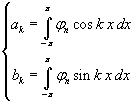If the elements of a given set are such that they can be submitted to the same operations we can do on n-dimensional real vectors, they are vectors and the set is a vector space.
This statement can be verified in particular for some set of functions of a given form.
Let's consider, for example, the set Σ2 of the functions
![]() with a and b real numbers and defined for x ∈ [-π ; π].
For simplicity sake, these functions will be shortly written
σ2(a,b) and sometime only σ2.
with a and b real numbers and defined for x ∈ [-π ; π].
For simplicity sake, these functions will be shortly written
σ2(a,b) and sometime only σ2.
Whichever two functions of Σ2 can be summed in the usual algebraic way giving a function of Σ2, so Σ2 is closed under the sum. The sum is associative and commutative. The neutral element of the sum is obviously σ2(0,0) and for every σ2(a,b) there is in Σ2 the opposite element σ2(-a,-b). Therefore Σ2 with the sum is a commutative group.
σ2(a,b) can be multiplied by a real number k giving σ2(ka,kb), so Σ2 is a vector space.
Moreover, given whichever functions σ2(a,b) and σ2(c,d), we have
![]()
The Wolfram Integrator speeds the calculation of this and other integrals in these pages.
The value of this integral coincides, apart from the constant factor π, with the scalar product between the real plane vectors (a,b) and (c,d). It seems therefore logical to take this integral as the expression of the scalar product between σ2(a,b) and σ2(c,d):
![]()
This definition allows to define a norm ||σ2|| for the vector |σ2>

So the set Σ2, like the set of the real plane vectors, is a normed vector space.
A linear operator L on Σ2 must transform univocally a vector into another vector in the same space and must have the same properties of the real square matrices with respect to real plane vectors hightlighted in section 2, that is

The second derivative of the functions of Σ2 with respect to the variable x has such properties; in fact the derivative of a sum of functions is the sum of the derivatives of each function and the derivative of the product of a function by a real number k is the product of the derivative of the function by k. Moreover

Therefore the double differentiation operator is a linear operator on Σ2. In order to calculate its eigenvalues and its eigenvectors (here its eigenfunctions) one must solve the equation
![]()
that is

This equation can be satisfied only if
![]()
So the eigenvalues of the double differentiation operator are λ1=-1 and λ2=-4; the corresponding eigenfunctions are σ2,1=a sinx and σ2,2=b sin2x.
Like in real plane vector space, these eigenfunctions can be normalized if we assume that the scalar factor a and b are positive and divide each vector for its norm. We obtain

The normalized set {σ2,1 , σ2,2} is an orthonormal basis of Σ2: each of these two functions has norm 1 and their scalar product is 0. All the vectors of Σ2 are linear combinations of these two functions just like all the plane real vectors are linear combinations of the vectors (1,0) e (0,1).
If we consider the set Γ2 of the functions
![]() defined for x ∈ [-π ; π], we reach analogous results.
defined for x ∈ [-π ; π], we reach analogous results.
The analogy persists also if we consider the set Φ2 of the functions
![]() which are such that
which are such that
![]() .
.
This integral gives a value that, apart from the constant factor π, coincides with the scalar product of the two 4-dimensional vectors (a,b,c,d) e (h,k,l,m).
By induction, we can infer that Φn, that is the set of the functions
![]() ,
is a normed vector space in which the norm is given by
,
is a normed vector space in which the norm is given by
 .
.
In particular, for whichever pair of functions
 we have
we have 
Therefore the union of the sets of the functions
![]() is an orthonormal basis of the vector space Φn and each function of
Φn can be expressed in the following way
is an orthonormal basis of the vector space Φn and each function of
Φn can be expressed in the following way

In conclusion, if we let

we have
![]()